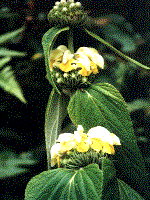 |
LAMIACEAE (formerly LABIATAE) - The Mint Family
This is a large plant family of mostly shrubs and herbs, distributed all over the world. It includes many well-known herbs (Mint, Sage, Thyme, Basil), ornamental plants (Coleus, Leonotis) and weeds (Henbit, Ground Ivy, Self-Heal). |
Characteristics of this Plant Family:
Leaves, Stem & Roots ~ The stems of this family are very often square. The leaves are simple and not divided, in pairs up the stem, each pair at right angles to the last, and they are frequently hairy or with scent glands.
Flowers ~ It is the flowers which give this plant family its original name of Labiatae. They have two lips, one more protruding than the other (labia is the Latin for 'lip'). Generally, the upper lip has two lobes and forms a hood over the lower lip, and the lower lip consists of three lobes which form a landing platform for pollinating insects. The flowers occur in whorls or circles round the stem, and each flower protrudes from a pointed calyx.
Recently, the international panel of botanists who rule on these things decided that all plant families ought to have the same ending (-aceae), and be named after a plant typical of the family, so the family is now called Lamiacae, after the type plant, Lamium (Dead Nettle).
Seeds ~ Each single flower can produce four seeds. They form at the base of the flower and develop inside the calyx. There is no seed pod. When the seeds are ripe, they simply roll out of the calyx.
(Click here for more information and examples of seedpods in this Family.)
Members of this Family usually have:
Square stems
Leaves in pairs up the stem
Flowers in circles round the stem
Flowers with hood at the top and lip at the bottom
Aromatic foliage